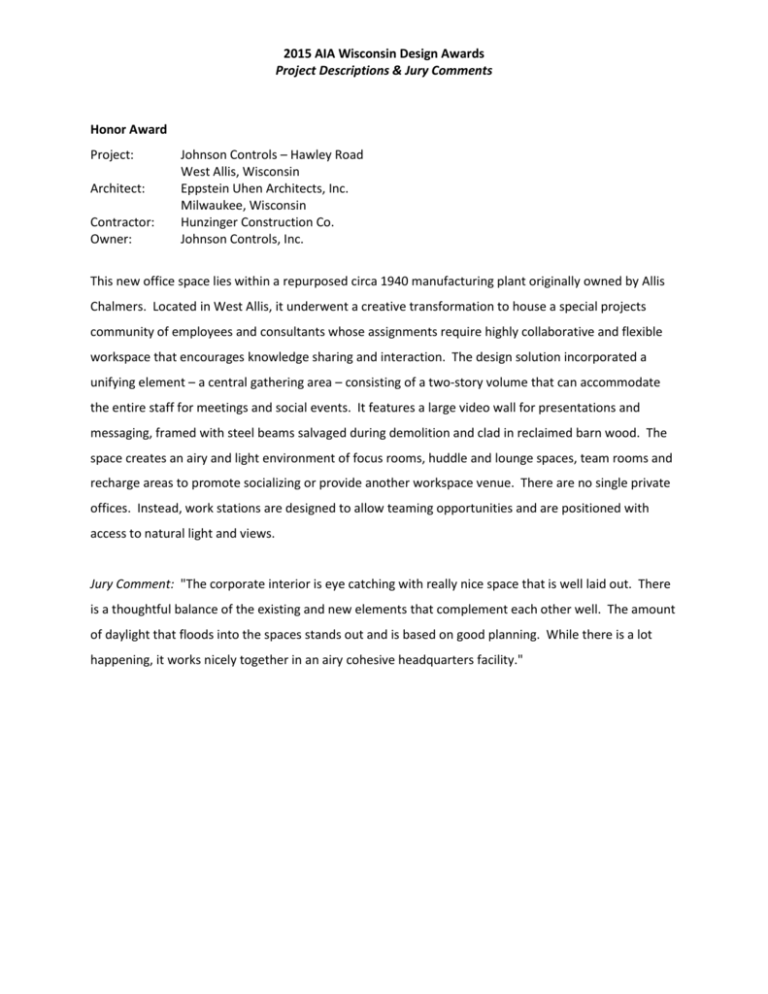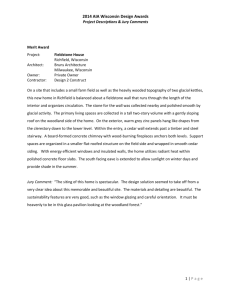Project Descriptions
advertisement

2015 AIA Wisconsin Design Awards Project Descriptions & Jury Comments Honor Award Project: Architect: Contractor: Owner: Johnson Controls – Hawley Road West Allis, Wisconsin Eppstein Uhen Architects, Inc. Milwaukee, Wisconsin Hunzinger Construction Co. Johnson Controls, Inc. This new office space lies within a repurposed circa 1940 manufacturing plant originally owned by Allis Chalmers. Located in West Allis, it underwent a creative transformation to house a special projects community of employees and consultants whose assignments require highly collaborative and flexible workspace that encourages knowledge sharing and interaction. The design solution incorporated a unifying element – a central gathering area – consisting of a two-story volume that can accommodate the entire staff for meetings and social events. It features a large video wall for presentations and messaging, framed with steel beams salvaged during demolition and clad in reclaimed barn wood. The space creates an airy and light environment of focus rooms, huddle and lounge spaces, team rooms and recharge areas to promote socializing or provide another workspace venue. There are no single private offices. Instead, work stations are designed to allow teaming opportunities and are positioned with access to natural light and views. Jury Comment: "The corporate interior is eye catching with really nice space that is well laid out. There is a thoughtful balance of the existing and new elements that complement each other well. The amount of daylight that floods into the spaces stands out and is based on good planning. While there is a lot happening, it works nicely together in an airy cohesive headquarters facility." 2015 AIA Wisconsin Design Awards Project Descriptions & Jury Comments Honor Award Project: Architect: Contractor: Owner: Pleated House Door County, Wisconsin Johnsen Schmaling Architects Milwaukee, Wisconsin Tielens Construction Private Client This home in Door County is a small compact residence nestled in a clearing on the edge of a gently sloping site where its low-slung silhouette disappears in the forest's dense vegetation. Designing an unassuming dwelling that shows an attitude of diffidence to the surrounding forest was a key program requirement. The building is clad in charred cedar from Northern Wisconsin, with its textured blackness complemented by varnished clear cedar, dark-anodized aluminum and glass. The charred wood boards were installed over furring strips of varying depths to form a gently folding and undulating building skin, similar to a pleated curtain. Visitors approach the house from a narrow gravel road that leads to a small trellised forecourt carved deep into the home’s rectangular mass. A continuous wall of milled lumber, stacked at slight angles and finished with a lustrous varnish to create a surface of folding ribbons, extends from the forecourt into the house. Inside, the vestibule connects to an open living space with an oversized sliding glass door system. A sculptural steel staircase leads to the bedroom suite and a large vegetated roof covering. The interior is dominated by white walls, white lacquered cabinets and a grey polished concrete floor. Jury Comment: "This is a really good house! While it seems simple, there is this layering of texture and materials that you start to appreciate as you get closer to the entry. It’s just really well done. It adds this richness and complexity that seems really appropriate for the setting. The detailing is incredible. There is a sophistication that shows the architects really know how to build houses. From the big concept down to the details, this is a really successful project – inside and out. It’s a very skillfully crafted home." 2 2015 AIA Wisconsin Design Awards Project Descriptions & Jury Comments Honor Award Project: Architect: Contractor: Owner: Collector’s Pavilion Chenequa, Wisconsin Vetter Denk Architects Milwaukee, Wisconsin True Inc. Private Client Inserted into a densely wooded landscape in Waukesha County, this striking building houses a private fitness space and vintage automobile gallery. The “collector’s pavilion” slides into the topography, with a folded roof plane that hovers over a board-formed concrete base. Attuned to privacy and security, the building possesses dual personalities, featuring a secure private bunker from the exterior while transforming into a warm inviting space in the interior. The use of indirect light as well as obscuring direct views from the public right-of-way provides adequate day light while ensuring strict privacy. The project’s shifting personality contrasts and merges with the environment depending on the season. The building employs meticulous detailing that harmonizes with its natural surroundings through its materiality, formal language and siting. Jury Comment: "This is an incredibly striking project. It’s a beautiful building that sits in its landscape in a compelling way. The concrete, wood and steel are the three materials that are consistently used throughout in a very thoughtful design. The use of concrete is particularly admirable. The way the polished floors, poured-in-place walls and how the module continues from the inside to the outside is well done and creates a very strong relationship. To come across this structure in the landscape would be a powerful moment." 3 2015 AIA Wisconsin Design Awards Project Descriptions & Jury Comments Merit Award Project: Architect: Contractor: Owner: MIAD Two50Two Student Residences Milwaukee, Wisconsin Engberg Anderson Architects Milwaukee, Wisconsin Northtrack Construction General Capital Group This project is the newest residence hall for students attending the Milwaukee Institute of Art and Design (MIAD). Located across the street from the main academic building and steps from the student union, the mixed-use building offers housing for students and creates an identifiable MIAD District within the historic Third Ward. The new building features five floors of housing above a ground-floor retail space. The fully furnished two-bedroom suites each accommodate four students, with a living room, kitchen and two bathrooms. Each floor also features student lounges, common study areas and laundry rooms. Outside, a second-story urban courtyard features a wood-planked “dock” and a small gathering area. The exterior of the building balances the rich industrial history of the urban area and the playfulness of the school. A masonry facade is made up of a simple pattern of large windows and exterior steel components to mirror the nearby historic bridges and warehouses and to add some color in the form of bright vertical spandrels. The project enhances the community and provides an opportunity for students to display their work inside and outside the building Jury Comment: "What we appreciate about this project is that there is a rigor to the exterior envelope, placement of windows and the organization of the facade. A nice interior element is the way that the exposed ceiling exploits the concrete construction. The exposed ducts are clean and neatly done, which allowed the architect to use more playful furniture. The public spaces also have a playful quality – the elevated courtyard for the students is a nice idea. It looks like an urban site with a thoughtfully considered design for a livable and interesting place for students. 4 2015 AIA Wisconsin Design Awards Project Descriptions & Jury Comments Merit Award Project: Architect: Contractor: Owners: Nexus House Madison, Wisconsin Johnsen Schmaling Architects Milwaukee, Wisconsin Yahara Builders, LLC Private Client This private family residence occupies a small lot in Madison’s historic University Heights neighborhood. The home was designed as a respectful but unapologetically contemporary building and discreetly placed in the back of the trapezoidal site to avoid direct visual competition with its two dignified 19th century neighbors. The house is a simple volume composed of two building blocks – a two-story brick podium partially embedded in the site’s existing slope and a linear cedar-clad meander that wraps up and over the podium before transforming into a cantilever. The home’s garage, support rooms and open living hall are located in the brick base, while its bedrooms, baths and a small reading room are housed in the cedar volume. The main living hall, an open space for cooking, eating and sitting, features a series of floor-to-ceiling windows that offer framed views into the neighborhood. The exterior material palette is limited to brick and wood, two materials common to the surrounding historic homes that together add a subtle muted nod to the bold colors of the neighborhood’s Victorian homes. Jury Comment: “As an extremely modern abstract house, there is something about the way the architect broke down the scale with the materials in the facade that helps it to so beautifully fit into the context of the neighborhood. The execution of this project is really precise. The architect paid a lot of attention to the details of the simple plan and massing. There are powerful moments where you are wrapped in the materials. For a modern single-family residence to fit into a historic neighborhood like this, there are a lot of different design moves like the use of materials, hiding the garage and the setback that all make it work really well." 5 2015 AIA Wisconsin Design Awards Project Descriptions & Jury Comments Merit Award Project: Architect: Contractor: Owner: Pabst Professional Center Milwaukee, WI Rinka Chung Architecture Inc. Milwaukee, Wisconsin Riley Construction Company, Inc. Blue Ribbon Management LLC This new five-story building is located in “The Brewery” district of Milwaukee on a site that once was home to the carriage and horse stables. A modern design, the building evokes an industrial quality reminiscent of its historic surroundings. It features a two-story parking structure and three floors of office space. The entry lobby, with double-height ceilings, opens to breakout business spaces and a private conference room. Referencing the nearby cream city buildings and iconic grain silos to the north, the project responds to its historic surroundings with simplicity and restraint while making a modern architectural statement for the future. The building incorporates modern materials in glass and metal panels, using masonry of dark brick cladding and warm wood tones. With floor-to-ceiling glass on its prominent corner, the project acts as a welcoming beacon for the revitalized district. Since its completion, the building project has helped to spur a renewed interest and sense of progress in downtown Milwaukee. Jury Comment: "This project is recognized for its interiors and, in particular, the materiality within the interiors. With impressive restraint, the design not only emphasizes the materiality and quality of the space, but also the connectivity to the city beyond. The simple use of wood for both the ceiling and walls offers a really nice sensibility. It’s a good example of restraint in assembly and detailing, which creates an overall effect of the space that works with the volume, works with the daylight, and works with the views. It provides a nice balance." 6 2015 AIA Wisconsin Design Awards Project Descriptions & Jury Comments Merit Award Project: Architect: Contractor: Owner: The Nest Bayfield, Wisconsin Bill Yudchitz, AIA, and Daniel Yudchitz, AIA Stevens Point, Wisconsin Revelations Architects/Builders Bill Yudchitz, AIA Sited on a hillside overlooking Lake Superior, this project is an experiment in contemporary elemental shelter. Its geometric forms and functionality commune with the natural setting, showing deference in a small footprint, use of utilitarian and economical construction materials, and ingenious versatility. The wood framed box – a sheltered container for living – is clad in black metal that floats above the landscape. When in use, two twelve-foot doors open to provide a protected porch entry and reveal a two-story glass wall. A shower screen supports a sand-filtered water cistern for the outdoor shower. The interior is organized into three vertical zones. The lower level is a multi-functional space that can be reconfigured for different uses. A series of built-in furniture elements include folding wooden chairs stored on wall hooks, a toilet and wash basin as well as a table and bed that fold out from the walls as needed. A ladder along the wall leads up to a sleeping loft with windows to the north and south. A second ladder allows access from the loft to a rooftop observation “nest.” Simple strategies, like lighting provided by solar lanterns, keep the building "off the grid." A dry-flush toilet and water jug eliminate the need for plumbing. The innovative shelter facilitates enjoying nature while respecting it. Jury Comment: "When we talk about what architects have to offer the general public, it’s this incredibly resourceful and efficient use of space. The architects did a lot with a little. This project is about how much you can pack in to such a small footprint. The lightness of the footprint, from both a sustainability stand point and how it touches the ground, implies a temporary insertion. It’s a smart design. You open it up and everything inside is dual purpose. There is an appropriateness and consistency in the material and detail choices. We applaud the idea – especially some of the furnishings and multipurpose design." 7








